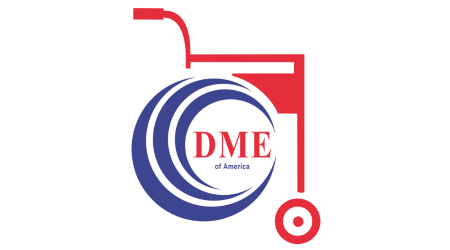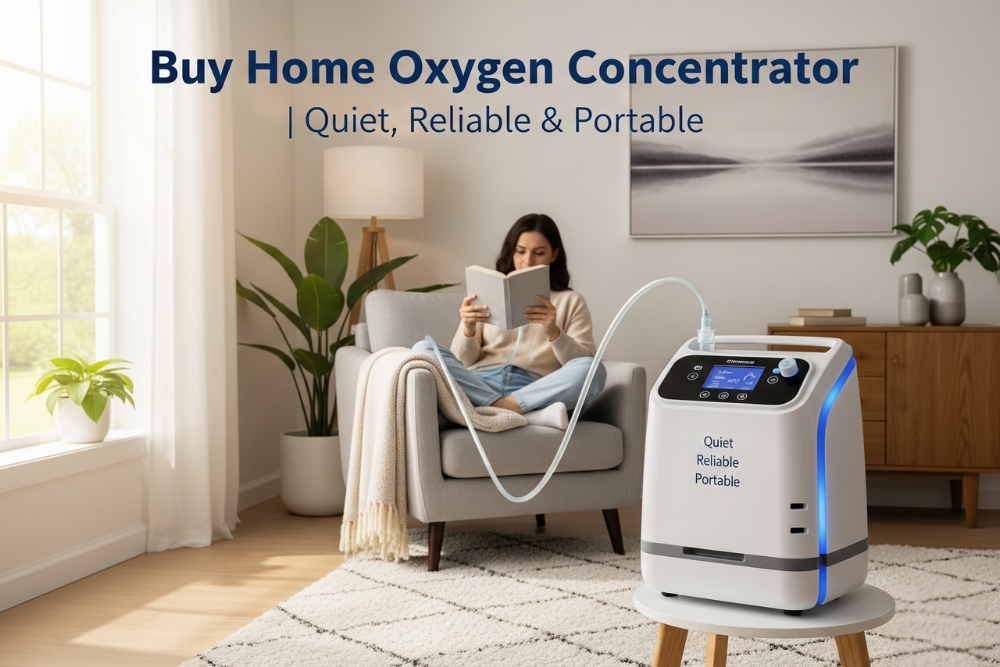Today, with the rapid development of technology, respiratory health management at home has been made simpler with the aid of medical oxygen equipment such as a home oxygen concentrator. The purchase of a home oxygen concentrator is equivalent to owning a device that lays the foundation for an oxygen therapy that is steady for ailments like COPD, emphysema, and sleep apnea. At DME OF America Inc., we deliver the best the most reliable, and long-lasting oxygen equipment that supports the oxygen supply to the patients and thus enables them to retain their freedom and standard of living. The low noise oxygen devices are intended for regular users and, stationary as well as mobile, suit different lifestyles.
As a result, regardless of whether you have chronic respiratory problems or are on the path of recovery, the presence of a home oxygen concentrator will positively alter your daily routine, as it will provide concentrated oxygen directly from the environment around you. In stark contrast with traditional oxygen tanks, these machines are not only efficient and economical but also do not require frequent refills. This guide will lead you through the benefits, kinds, and essential characteristics of an oxygen concentrator to help you find the most suitable one for home use. Thus, the decision for the right respiratory care will be yours.
Understanding Home Oxygen Concentrator for Effective Oxygen Therapy:
A home oxygen concentrator is a device that takes in the air around the house, cleans it to a therapeutic level of 90-95%, and then provides oxygen for medical use. This oxygen therapy equipment is the "lung" for people with low blood oxygen and offers a non-invasive method to keep the lungs working. Stationary models are perfect for managing respiratory health at home, while portable ones provide the freedom to move around without losing oxygen supply.
Such apparatus functions by drawing in the air, selecting out nitrogen, and feeding in a mixture of oxygen and normal air through the nasal cannula or mask. In patients with COPD, oxygen support, the use of the home oxygen concentrator is instrumental in avoiding complications like heart strain and making the general condition better. The opinion of medical professionals is that oxygen therapy at home regularly is instrumental in prolonging the life of a patient with severe hypoxemia and thus is the basis of contemporary respiratory care.
Benefits of Home Oxygen Therapy with Reliable Oxygen Supply Devices:
Using home oxygen therapy, which is part of your treatment plan, is a great way to improve your lung health in many ways. The main benefit is less breathlessness, thus you will be able to do your everyday activities without getting tired quickly. Moreover, it raises the person's vitality and contributes to sound rest, which is important for people with sleep apnea or emphysema.
Using a quiet oxygen device for an extended period of time can improve your exercise tolerance, keeping you independent and active. You can actually get out, move around, and not feel like you’re running a marathon just for walking to the mailbox. Through efficient symptom management and oxygen level stabilization, it lowers hospital visits for individuals with COPD. Additionally, as proper oxygenation helps brain health, these reliable oxygen supply devices enhance mood and cognitive performance. You can guarantee reliable performance and peace of mind by selecting long-lasting medical equipment from reliable suppliers like mobility scooters at DME OF America Inc.
Types of Home Oxygen Concentrator: Stationary vs Portable for Home Use:
One of the most essential things in choosing an oxygen concentrator for home use is knowing the different types. Picking out an oxygen concentrator for home isn’t exactly a walk in the park you’ve got options, and knowing the difference actually matters. A stationary oxygen concentrator is a device that is intended to be used at home continuously for a long time. It can give a maximum flow rate of 10 liters per minute (LPM) and is compatible with a standard outlet. These are solid, energy-efficient, and perfect for a setup for respiratory care during the night.
On the contrary, portable oxygen concentrators are generally lightweight (usually less than 10 pounds) and run on batteries, which makes them the perfect devices for trips or any activities outside. These portable oxygen machines can provide either a pulse-dose or a continuous flow, thus giving a person with an active lifestyle the needed flexibility. While stationary models are the most reliable for home oxygen therapy and portables are the most mobile without compromising on purity of oxygen.
| Feature | Stationary Oxygen Concentrator | Portable Oxygen Concentrator |
| Weight | 18-30 pounds | 3-10 pounds |
| Flow Rate | Up to 10 LPM continuous | 1-5 LPM pulse/continuous |
| Power Source | AC outlet | Battery, AC, DC |
| Best For | Home-based respiratory health | On-the-go COPD oxygen support |
| Noise Level | 40-50 dB (quiet models) | Under 40 dB |
| Price Range | $500-$1,500 | $1,500-$3,000 |
To assist you in selecting the appropriate medical oxygen equipment, this table emphasizes important distinctions.
Key Features to Consider When Buying Quiet and Reliable Home Oxygen Concentrator:
If you really want to get the right home oxygen concentrator for you, then you need to dig deep into the features of the product. Check out models that offer not least 90% of oxygen concentration and have an adjustable flow rate as per your prescription. The noise level plays an important role; quiet oxygen devices with less than 45 dB would be perfect so that your sleep or daily routine is not disturbed.
The dependability of the product comes from a strong build, a long warranty period (3-5 years), and low maintenance. Being energy-efficient will help you save on your electricity costs, while the portability aspect, which consists of a wheel or a carrying bag, will make it more user-friendly. The safety alarm for low oxygen and power failure will give you peace of mind.
At DME OF America Inc., our range covers leading brands like Philips Respironics, Inogen, and Rhythm Healthcare, which have been established as highly reliable home medical device brands.
Top Recommendations for Home Oxygen Concentrators in 2025:
Based on recent reviews, the Philips Respironics EverFlo stands out as the best overall for its quiet operation (40 dB) and 5 LPM flow. The Inogen At Home 5L is highly energy-efficient, consuming less power while delivering a reliable oxygen supply. For value, the Drive Medical DeVilbiss 5 Liter offers durability and ease of use at an affordable price.
Portable options like the CAIRE FreeStyle Comfort provide excellent mobility with long battery life. Always consult your doctor and check for FAA approval if traveling. These recommendations ensure you get high-quality oxygen therapy equipment tailored to your respiratory health needs.
How to Choose the Right Oxygen Therapy Equipment for Your Home Needs:
Selecting a home oxygen concentrator that fits your needs the best will require you to analyze your lifestyle, medication, and budget. Make a start with a doctor's diagnosis to figure out the usage flow, and then check out different models to find one with your desired features, like being light and less noisy. It is also a good idea to think about whether you want to buy the device or merely use it for a while as a rental. Make sure the device that you are using meets Medicare guidelines if you are eligible. We, at DME OF America Inc, are the professionals who provide you with the necessary guidance for buying an oxygen concentrator online.
Conclusion:
Picking a suitable home oxygen concentrator is an essential measure that leads to better respiratory health and an increase in your quality of life. We at DME OF America Inc. supply discreet, dependable, and mobile products that match your individual requirements for oxygen therapy, be it for COPD, emphysema, or any other respiratory disorder. Our healthcare oxygen gadgets, which are designed with a focus on longevity and user-friendliness, enable you to enjoy an active and independent life. It is time to shop from our selection of oxygen concentrators to get the one that suits your home or travel needs best and give yourself the comfort and assurance that come with good respiratory care.
FAQs
What distinguishes home oxygen units that are stationary from those that are portable?
Stationary models can deliver higher continuous flow to a patient with home oxygen therapy, while portable ones, with battery power, allow the user to walk around with COPD oxygen support.
How can I keep my home medical device's oxygen supply consistent?
In order to maintain the efficient operation of your quiet oxygen device, you need to clean the filters, check the alarms, and arrange for a professional service regularly.
Does insurance cover home oxygen concentrators for respiratory health needs?
It is highly likely that many insurance plans will cover the cost of durable medical equipment such as oxygen concentrators if prescribed, however, always make sure with your provider first.
What kind of oxygen therapy equipment flow rate should I seek?
Typically, flow rates of 2-5 LPM are what are used at home, and the final decision should be made by your doctor in order to set up effective respiratory care.
Can I bring a portable oxygen concentrator on a trip?
Yes, FAA-approved models allow air travel, providing a reliable oxygen supply during trips.
Ofcourse, models that have been granted approval by the FAA enable flights in the air, making a safe and reliable oxygen supply.

